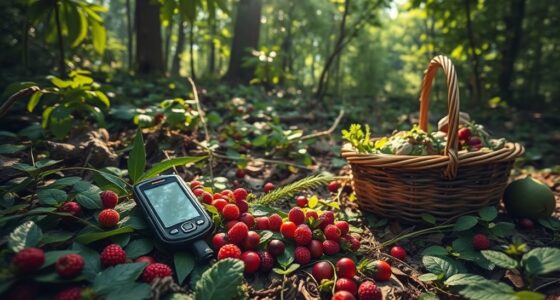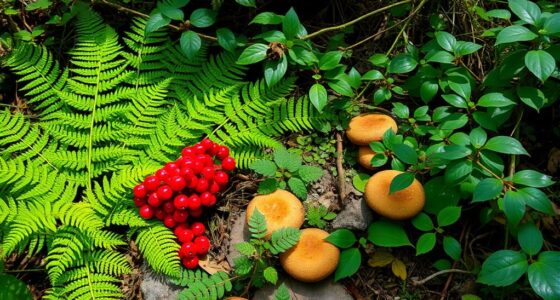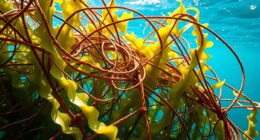To practice ethical harvesting and maximize flavor without harming nature, always follow local laws and obtain permits when needed. Harvest sustainably by taking only what you need, leaving enough behind for regrowth, and avoiding fragile areas. Use proper tools and be gentle to prevent soil and plant damage, while minimizing your footprint. Respect wildlife and avoid loud noises or disturbance. If you carry on, you’ll discover more ways to enjoy wild flavors responsibly.
Key Takeaways
- Identify and harvest only what is necessary, avoiding overcollection to protect plant populations and ecosystems.
- Use sustainable tools and techniques that minimize soil disturbance and damage to surrounding vegetation.
- Harvest during appropriate seasons to ensure plant recovery and reduce stress on wild populations.
- Follow local regulations and obtain permits to ensure legal and environmentally responsible foraging.
- Leave no trace by packing out all debris and respecting wildlife habitats to preserve natural beauty and biodiversity.

In today’s sustainable world, adopting ethical harvesting tactics is essential for maintaining ecological balance and respecting natural resources. When you engage in sustainable foraging, you help ensure that plant populations remain healthy and viable for future generations. One of the most critical aspects of ethical harvesting is understanding the legal considerations that surround wild plant collection. Laws vary by region, and some areas restrict or prohibit harvesting certain species to protect ecosystems. Before you venture out, research local regulations, obtain any necessary permits, and respect protected areas. Being aware of these legal boundaries not only keeps you compliant but also demonstrates your commitment to conservation.
Practicing sustainable foraging involves more than just following the law; it requires mindfulness about how much and what you harvest. Never take more than you need, and always leave enough behind so the plant can continue to grow and reproduce. This might mean collecting only a small portion of a patch or choosing to harvest during specific times when plants are less vulnerable. By doing so, you prevent depletion of wild populations and contribute to the health of the ecosystem. Additionally, avoid damaging the surrounding environment—step carefully, avoid trampling delicate plants or disturbing soil, and steer clear of overharvesting in sensitive habitats.
Harvest only what you need, leave enough for the plant to thrive, and protect fragile ecosystems.
Another key aspect is identification. Make sure you are 100% certain about the species you’re collecting. Mistaking a toxic or protected plant for an edible one can have serious consequences, both for your health and for conservation efforts. Educate yourself using reliable guides or seek advice from experienced foragers. When harvesting, use clean tools to minimize disease spread and avoid damaging the plant’s root systems unless you’re harvesting sustainably and responsibly.
Respecting the land is also about being discreet and considerate. Leave no trace of your visit—pack out all trash, avoid making loud noises, and don’t disturb wildlife. This approach ensures that others can enjoy the natural environment as well and that the habitat remains healthy. Remember, ethical harvesting isn’t just about legal compliance; it’s about cultivating a respectful relationship with nature. Incorporating the use of appropriate tools can help minimize damage and promote sustainable practices. When you prioritize sustainability and adhere to legal considerations, you help preserve the richness of our wild landscapes. Your mindful practices support resilient ecosystems, ensuring that future generations can enjoy the flavors and benefits of wild plants while maintaining the delicate balance of nature.
Frequently Asked Questions
How Do I Identify Sustainable Harvesting Locations?
To identify sustainable harvesting locations, you should observe the plant population for signs of over-harvesting or decline. Look for healthy habitat conditions that support diverse plant life and make certain the ecosystem’s overall health remains intact. Avoid areas with fragile or endangered species, and opt for sites where plants grow abundantly without signs of stress. This way, you help maintain habitat health while enjoying your harvest responsibly.
What Tools Are Best for Ethical Foraging?
Ever wonder what tools make foraging both effective and ethical? You’ll want a good field guide for edible plant identification, which helps you distinguish safe, sustainable options. A sharp knife or scissors can minimize damage to plants, while a basket or breathable bag keeps your harvest fresh without harming the environment. Using these foraging techniques guarantees you gather responsibly, respecting nature’s balance while enjoying the flavors of wild foods.
Are There Legal Restrictions on Harvesting Wild Plants?
You need to be aware of legal restrictions on harvesting wild plants, as legal compliance varies by location. Always check local permits and regulations before you gather, because some areas require permits or prohibit certain species altogether. Ignoring these rules can lead to fines or damaging ecosystems. Stay informed about specific laws in your region to guarantee your harvesting practices are ethical and legal, supporting sustainable foraging for everyone.
How Can I Avoid Overharvesting in Fragile Ecosystems?
Imagine your actions ripple through fragile ecosystems, like stones skimming a still pond. To avoid overharvesting, you should harvest sparingly, always respecting wildlife disturbance and avoiding invasive species. Use sustainable practices, like selective picking and leaving enough behind, to guarantee plants continue thriving. Educate yourself about local regulations and ecosystem needs. By acting thoughtfully, you protect biodiversity and keep nature’s balance intact for future generations.
What Are Common Mistakes to Prevent in Harvesting Practices?
When harvesting, you should avoid common mistakes like overharvesting and disrupting plant propagation cycles. Always consider seasonal timing to make certain plants have time to recover and reproduce. Don’t take more than you need, and be mindful of the ecosystem’s balance. By paying attention to these factors, you help protect fragile ecosystems and promote sustainable harvesting practices, ensuring the environment remains healthy for future generations.
Conclusion
By embracing ethical harvesting tactics, you become a steward of the land, nurturing a delicate garden that thrives for generations. Think of yourself as a gentle gardener, tending to each plant with care and respect, ensuring the soil remains rich and alive. When you harvest responsibly, you’re not just taking what you need—you’re planting the seeds for a sustainable future. Leave no trace behind, and watch your actions bloom into a legacy of flavor and respect.










